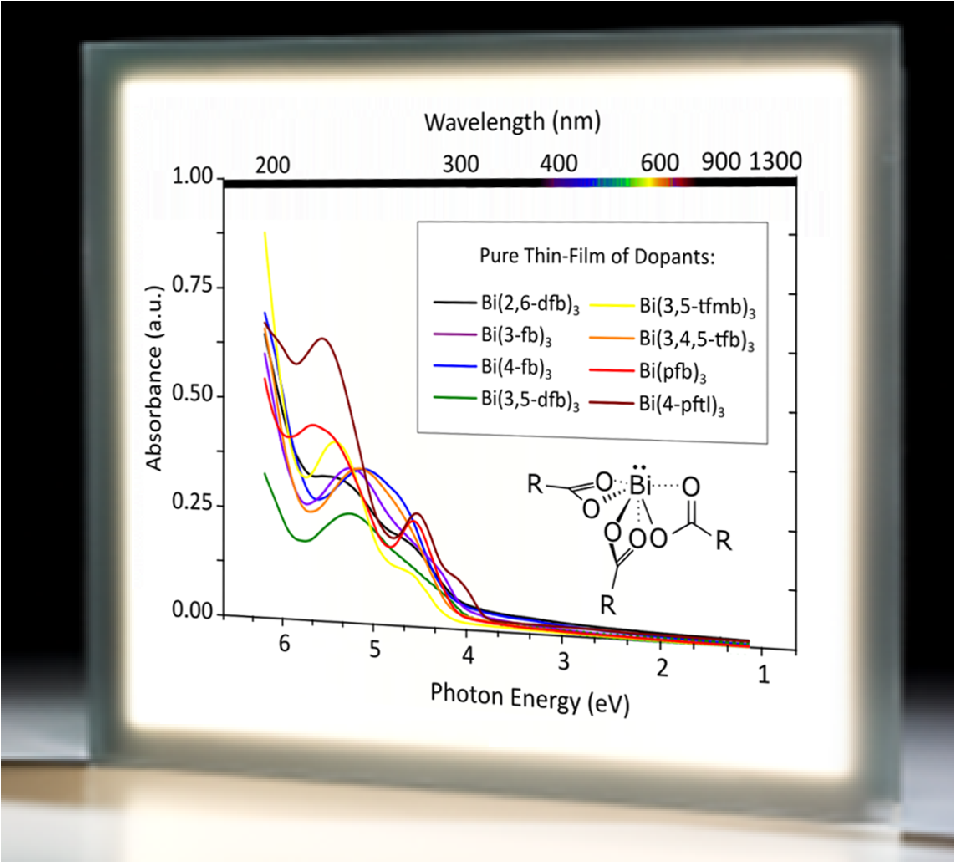









 Abstract: The invention relates to an organic electronic component (100) comprising at least one charge generation layer (5) which has an organically p-doped region (5a) that contains a zinc complex as a p-dopant, said zinc complex in turn containing at least one ligand L of the following structure: formula (I) wherein R1 and R2 can be oxygen, sulphur, selenium, NH or NR4 independently from one another, wherein R4 is selected from the group containing alkyl or aryl and which can be bonded to R3; and wherein R3 is selected from the group containing alkyl, long-chain alkyl, cycloalkyl, halogen alkyl, at least partially halogenated long-chain alkyl, halogen cycloalkyl, aryl, arylene, halogen aryl, heteroaryl, heteroarylene, heterocyclic alkylene, heterocycloalkyl, halogen heteroaryl, alkenyl, halogen alkenyl, alkynyl, halogen alkynyl, ketoaryl, halogen ketoaryl, ketoheteroaryl, ketoalkyl, halogen ketoalkyl, ketoalkenyl, halogen ketoalkenyl, halogen alkyl aryl, and halogen alkyl heteroaryl, wherein, for suitable gr oups, one or a number of non-adjacent CH2 groups can be replaced by -O-, -S-, -NH-, -NR°°°-, -SiR°R°°-, -CO-, -COO-, -COR°OR°°-, -OCO-, -OCO-O-, -SO2-, -S-CO-, -CO-S-, -O-CS-, -CS-O-, -CY1=CY2 or -C≡C- independently from one another, and in such a way that O and/or S atoms are not directly bonded to one another, and are replaced optionally with aryl- or heteroaryl preferably containing between 1 and 30 C atoms (terminal CH3 groups are understood to be CH2 groups in the sense of CH2-H). The invention further relates to the use of a zinc complex as a p-dopant in charge generation layers.
Abstract: The invention relates to an organic electronic component (100) comprising at least one charge generation layer (5) which has an organically p-doped region (5a) that contains a zinc complex as a p-dopant, said zinc complex in turn containing at least one ligand L of the following structure: formula (I) wherein R1 and R2 can be oxygen, sulphur, selenium, NH or NR4 independently from one another, wherein R4 is selected from the group containing alkyl or aryl and which can be bonded to R3; and wherein R3 is selected from the group containing alkyl, long-chain alkyl, cycloalkyl, halogen alkyl, at least partially halogenated long-chain alkyl, halogen cycloalkyl, aryl, arylene, halogen aryl, heteroaryl, heteroarylene, heterocyclic alkylene, heterocycloalkyl, halogen heteroaryl, alkenyl, halogen alkenyl, alkynyl, halogen alkynyl, ketoaryl, halogen ketoaryl, ketoheteroaryl, ketoalkyl, halogen ketoalkyl, ketoalkenyl, halogen ketoalkenyl, halogen alkyl aryl, and halogen alkyl heteroaryl, wherein, for suitable gr oups, one or a number of non-adjacent CH2 groups can be replaced by -O-, -S-, -NH-, -NR°°°-, -SiR°R°°-, -CO-, -COO-, -COR°OR°°-, -OCO-, -OCO-O-, -SO2-, -S-CO-, -CO-S-, -O-CS-, -CS-O-, -CY1=CY2 or -C≡C- independently from one another, and in such a way that O and/or S atoms are not directly bonded to one another, and are replaced optionally with aryl- or heteroaryl preferably containing between 1 and 30 C atoms (terminal CH3 groups are understood to be CH2 groups in the sense of CH2-H). The invention further relates to the use of a zinc complex as a p-dopant in charge generation layers.
Kessler F., Maltenberger A., Pecqueur S., Pentlehner D., Regensburger S., Schmid G.

 Abstract: Ten new efficient p-dopants for conductivity doping of organic semiconductors for OLEDs are identified. The key advantage of the electrophilic tris(carboxylato) bismuth(III) compounds is the unique low absorption of the resulting doped layers which promo tes the efficiency of OLED devices. The combination of these features with their low fabrication cost, volatility, and stability, make these materials very attractive as dopants in organic electronics.
Abstract: Ten new efficient p-dopants for conductivity doping of organic semiconductors for OLEDs are identified. The key advantage of the electrophilic tris(carboxylato) bismuth(III) compounds is the unique low absorption of the resulting doped layers which promo tes the efficiency of OLED devices. The combination of these features with their low fabrication cost, volatility, and stability, make these materials very attractive as dopants in organic electronics.
Pecqueur S., Maltenberger A., Petrukhina M. A., Halik M., Jaeger A., Pentlehner D., Schmid G.*

 Abstract: The invention relates to an organic electronic component having a matrix containing a zinc complex as a p-dopant, said zinc complex in turn containing at least one ligand L of the following structure: formula (I) wherein R1 and R2 can be oxygen, sulphur, selenium, NH or NR4 independently from one another, wherein R4 is selected from the group containing alkyl or aryl and which can be bonded to R3, and wherein R3 is selected from the group containing alkyl, long-chain alkyl, cycloalkyl, halogen-alkyl, ar yl, arylene, halogen-aryl, heteroaryl, heteroarylene, heterocyclic-alkylene, heterocycloalkyl, halogen-heteroaryl, alkenyl, halogen-alkenyl, alkynyl, halogen-alkynyl, ketoaryl, halogen-ketoaryl, ketoheteroaryl, ketoalkyl, halogen-ketoalkyl, ketoalkenyl, halogen-ketoalkenyl, halogen-alkyl-aryl, halogen-alkyl-heteroaryl, wherein, for suitable groups, one or a number of non-adjacent CH2-groups can be replaced by -O-, -S-, -NH-, -NR°°°-, -SiR°R°°-, -CO-, -COO-, -COR°OR °°-, -OCO-, -OCO-O-, -SO2-, -S-CO-, -CO-S-, -O-CS-, -CS-O-, -CY1=CY2 or -C≡C- independently from one another, and in such a way that O and/or S atoms are not directly bonded to one another, and are replaced optionally with aryl- o r heteroaryl preferably containing between 1 and 30 C atoms (terminal CH3 -groups are understood to be CH2 -groups in the sense of CH2 -H).
Abstract: The invention relates to an organic electronic component having a matrix containing a zinc complex as a p-dopant, said zinc complex in turn containing at least one ligand L of the following structure: formula (I) wherein R1 and R2 can be oxygen, sulphur, selenium, NH or NR4 independently from one another, wherein R4 is selected from the group containing alkyl or aryl and which can be bonded to R3, and wherein R3 is selected from the group containing alkyl, long-chain alkyl, cycloalkyl, halogen-alkyl, ar yl, arylene, halogen-aryl, heteroaryl, heteroarylene, heterocyclic-alkylene, heterocycloalkyl, halogen-heteroaryl, alkenyl, halogen-alkenyl, alkynyl, halogen-alkynyl, ketoaryl, halogen-ketoaryl, ketoheteroaryl, ketoalkyl, halogen-ketoalkyl, ketoalkenyl, halogen-ketoalkenyl, halogen-alkyl-aryl, halogen-alkyl-heteroaryl, wherein, for suitable groups, one or a number of non-adjacent CH2-groups can be replaced by -O-, -S-, -NH-, -NR°°°-, -SiR°R°°-, -CO-, -COO-, -COR°OR °°-, -OCO-, -OCO-O-, -SO2-, -S-CO-, -CO-S-, -O-CS-, -CS-O-, -CY1=CY2 or -C≡C- independently from one another, and in such a way that O and/or S atoms are not directly bonded to one another, and are replaced optionally with aryl- o r heteroaryl preferably containing between 1 and 30 C atoms (terminal CH3 -groups are understood to be CH2 -groups in the sense of CH2 -H).
Kessler F., Maltenberger A., Pecqueur S., Regensburger S., Schmid G.

 Abstract: The invention relates to a method for producing an organic electronic component, wherein the component comprises at least one organic electronic layer having a matrix, wherein the matrix contains a metal complex as a dopant, which metal complex comprises at least one metal atom M and at least one ligand L bonded to the metal atom M, wherein the ligands L have the following structure independently of each other: wherein E1 and E2 can be oxygen, sulfur, selenium, NH, or NR' independently of each other, wh erein R' is selected from the group containing alkyl or aryl and can be bonded to the substituted benzene ring of the ligand L; and the substituents R1 are selected independently of each other from the group comprising branched or unbranched, fluorinated aliphatic hydrocarbons having 1 to 10 C atoms, wherein n = 1 to 5; and the substituents R2 are selected independently of each other from the group comprising -CN, branched or unbranched aliphatic hydrocarbons having 1 to 10 C atoms, aryl, and heteroaryl , wherein m = 0 to at most 5 - n; wherein the deposition of the dopant of the at least one organic electronic layer occurs by means of gas-phase deposition by use of a source, wherein the source is designed in such a way that the dopant experiences impac ts with at least one wall of the source.
Abstract: The invention relates to a method for producing an organic electronic component, wherein the component comprises at least one organic electronic layer having a matrix, wherein the matrix contains a metal complex as a dopant, which metal complex comprises at least one metal atom M and at least one ligand L bonded to the metal atom M, wherein the ligands L have the following structure independently of each other: wherein E1 and E2 can be oxygen, sulfur, selenium, NH, or NR' independently of each other, wh erein R' is selected from the group containing alkyl or aryl and can be bonded to the substituted benzene ring of the ligand L; and the substituents R1 are selected independently of each other from the group comprising branched or unbranched, fluorinated aliphatic hydrocarbons having 1 to 10 C atoms, wherein n = 1 to 5; and the substituents R2 are selected independently of each other from the group comprising -CN, branched or unbranched aliphatic hydrocarbons having 1 to 10 C atoms, aryl, and heteroaryl , wherein m = 0 to at most 5 - n; wherein the deposition of the dopant of the at least one organic electronic layer occurs by means of gas-phase deposition by use of a source, wherein the source is designed in such a way that the dopant experiences impac ts with at least one wall of the source.
Maltenberger A., Pecqueur S., Regensburger S., Schmid G.

 Abstract: The invention relates to a method for producing hole-transporting electrical layers, wherein a functionalized organic matrix compound is reacted with at least one cross-linking reagent on a substrate, higher-molecular-weight compounds thus being formed, wherein the functionalized organic matrix compound corresponds to the following formula 1, wherein L is a bond or is selected from the group comprising substituted or unsubstituted, saturated or unsaturated C1-C50 alkyl, aryl, polye thylene glycol, polyethylene diamine, polyester, polyurethane, or polyvinylidene phenyl chains or mixtures thereof; E1 and E2 can be oxygen, sulfur, selenium, NH, or NE3 independently of each other, wherein E3 is selected from the group compri sing substituted or unsubstituted alkyl or aryl, wherein E3 can be bonded to R; R is selected from the group comprising H, D, C1-C10 alkyl or aryl silyl ester, fluorinated or unfluorinated branched or unbranched C1-C 10 alkyl, aryl, or heteroaryl, and RHTL is the backbone of an organic hole transporter, and the cross-linking reagent comprises at least one metal atom from groups 13-15 and at least one organic ligand.
Abstract: The invention relates to a method for producing hole-transporting electrical layers, wherein a functionalized organic matrix compound is reacted with at least one cross-linking reagent on a substrate, higher-molecular-weight compounds thus being formed, wherein the functionalized organic matrix compound corresponds to the following formula 1, wherein L is a bond or is selected from the group comprising substituted or unsubstituted, saturated or unsaturated C1-C50 alkyl, aryl, polye thylene glycol, polyethylene diamine, polyester, polyurethane, or polyvinylidene phenyl chains or mixtures thereof; E1 and E2 can be oxygen, sulfur, selenium, NH, or NE3 independently of each other, wherein E3 is selected from the group compri sing substituted or unsubstituted alkyl or aryl, wherein E3 can be bonded to R; R is selected from the group comprising H, D, C1-C10 alkyl or aryl silyl ester, fluorinated or unfluorinated branched or unbranched C1-C 10 alkyl, aryl, or heteroaryl, and RHTL is the backbone of an organic hole transporter, and the cross-linking reagent comprises at least one metal atom from groups 13-15 and at least one organic ligand.
Maltenberger A., Pecqueur S., Schmid G.

 Abstract: The invention relates to a bi- or polynuclear metal complex of a metal of groups Vb/VIb/VIIb, or rather groups 5-7, having at least one ligand of the structure (a), wherein R1 and R2, independently of each other, can be oxygen, sulfur, selenium, NH, or N R4, wherein R4 is selected from the group containing alkyl or aryl and can be bonded to R3; and R3 is selected from the group containing alkyl, long-chain alkyl, alkoxy, long-chain alkoxy, cycloalkyl, haloalkyl, aryl, arylenes, haloaryl, heteroaryl, hete roarylenes, heterocycloalkylenes, heterocycloalkyl, haloheteroaryl, alkenyl, haloalkenyl, alkynyl, haloalkynyl, ketoaryl, haloketoaryl, ketoheteroaryl, ketoalkyl, haloketoalkyl, ketoalkenyl, haloketoalkenyl, wherein for suitable residues, one or more non -adjacent CH2 groups can be replaced, independently of each other, with -O-, -S-, -NH-, -NR°-, -SiR°R°°-, -CO-, -COO-, -OCO-, -OCO-O-, -SO2-, -S-CO-, -CO-S-, -CY1=CY2, or -C≡C- in such a way that O and/or S atom s are not bonded directly to each other, likewise optionally are replaced with aryl or heteroaryl preferably containing 1 to 30 C atoms, as a p-type doping agent for matrix materials of electronic components.
Abstract: The invention relates to a bi- or polynuclear metal complex of a metal of groups Vb/VIb/VIIb, or rather groups 5-7, having at least one ligand of the structure (a), wherein R1 and R2, independently of each other, can be oxygen, sulfur, selenium, NH, or N R4, wherein R4 is selected from the group containing alkyl or aryl and can be bonded to R3; and R3 is selected from the group containing alkyl, long-chain alkyl, alkoxy, long-chain alkoxy, cycloalkyl, haloalkyl, aryl, arylenes, haloaryl, heteroaryl, hete roarylenes, heterocycloalkylenes, heterocycloalkyl, haloheteroaryl, alkenyl, haloalkenyl, alkynyl, haloalkynyl, ketoaryl, haloketoaryl, ketoheteroaryl, ketoalkyl, haloketoalkyl, ketoalkenyl, haloketoalkenyl, wherein for suitable residues, one or more non -adjacent CH2 groups can be replaced, independently of each other, with -O-, -S-, -NH-, -NR°-, -SiR°R°°-, -CO-, -COO-, -OCO-, -OCO-O-, -SO2-, -S-CO-, -CO-S-, -CY1=CY2, or -C≡C- in such a way that O and/or S atom s are not bonded directly to each other, likewise optionally are replaced with aryl or heteroaryl preferably containing 1 to 30 C atoms, as a p-type doping agent for matrix materials of electronic components.
Maltenberger A., Pecqueur S., Schmid G., Wemken J. H.
© 2019-2025 Sébastien Pecqueur